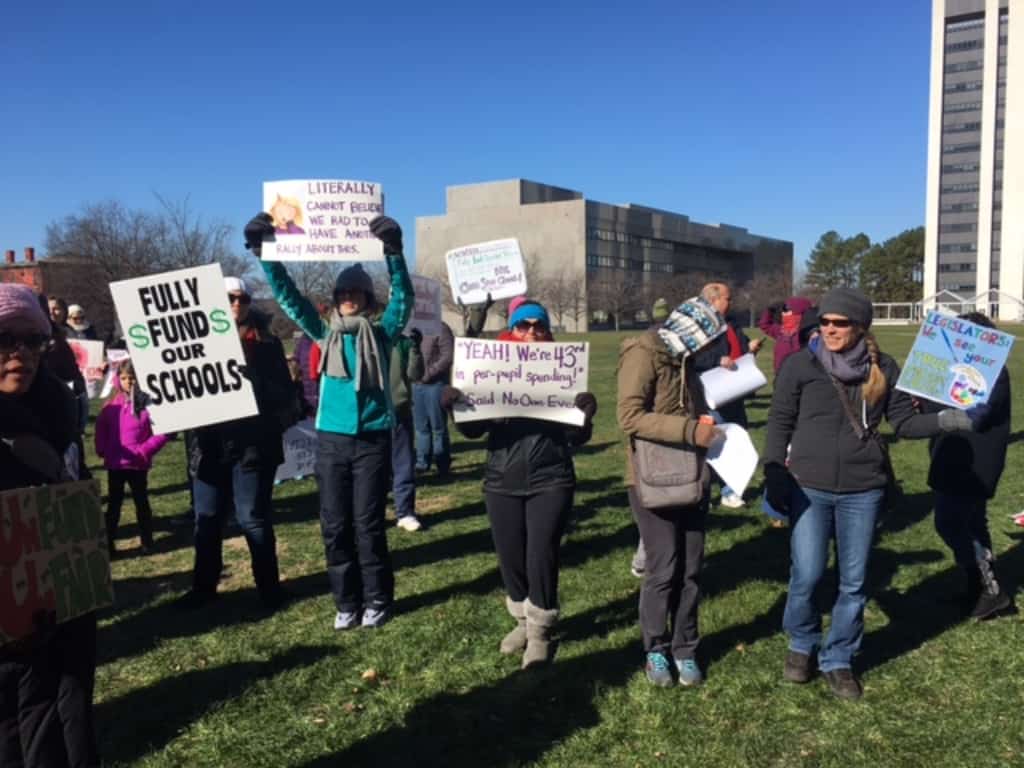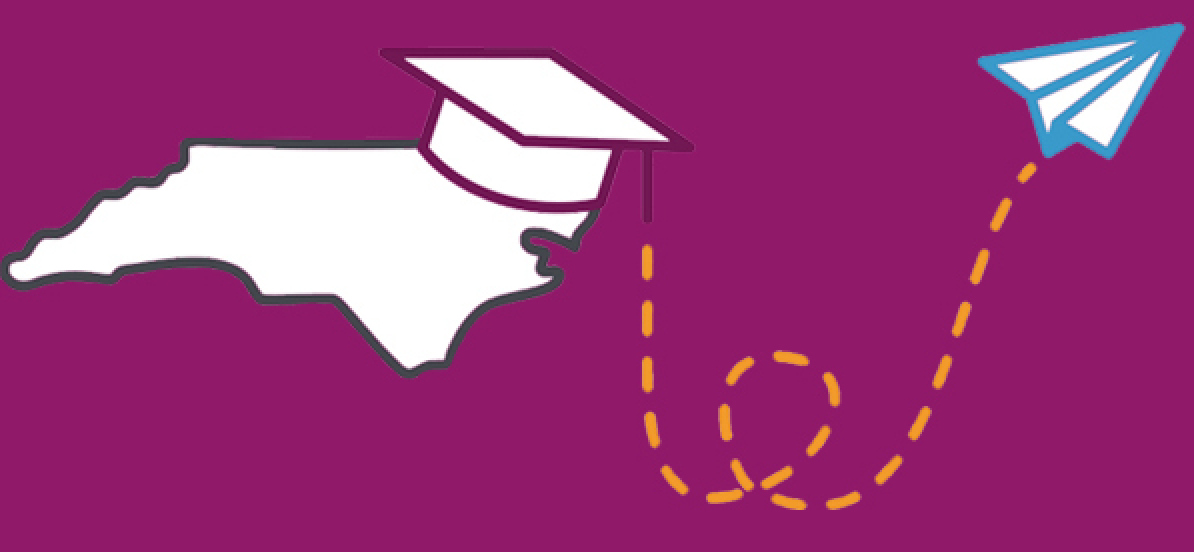
If you made it out of your house last weekend, you may have seen a group of parents, teachers, and children outside in the cold behind the General Assembly. They were protesting class size restrictions on kindergarten through third grade classes passed by the General Assembly in 2016 that essentially cut funding for extracurricular teachers.
Lawmakers tried to fix this in the 2017 legislative session, but they ended up delaying implementation of the restrictions until next school year. They are expected to return to this issue sometime before the short session begins in May.
Given the impact this legislation will have on schools if the restrictions take effect next year, we wanted to hear from teachers about their thoughts on the class size debate. In October, we sent a survey through our Reach NC Voices platform to 59,008 public school teachers[1] in North Carolina. To date, it has had 14,822 unique viewers.
Of the 2,287 respondents, 94 percent stated they were public school teachers in North Carolina and 6 percent were not. Those that indicated they were not teachers were directed to the end of the survey. Teachers from 84 school districts and all grades (pre-kindergarten to 12th grade) as well as arts, music and physical education participated in the survey.
Thirty-one percent of teachers said they taught kindergarten, 1st, 2nd, and/or 3rd graders, including in arts, music and physical education. Most respondents utilize technology in their classrooms, with 80 percent saying they use it often, 18 percent use it sometimes, 2 percent rarely use it, and 0 percent never use it.
Teachers want smaller class sizes but not at expense of specialties and larger fourth and fifth grade classes
This survey found that North Carolina public school teachers seemed to have a largely negative perception of the K-3 class size restrictions despite believing that smaller class sizes are beneficial for student learning.
The majority of respondents (76 percent) think a hard cap on class sizes will result in a space crunch or cuts in other areas such as specialty teachers and teachers assistants.
Teachers also noted that fourth and fifth grade class sizes are increasing in some schools because they are moving those teachers to lower elementary classes to comply with the class size restrictions.
Teachers who responded said teachers’ assistants and specialty teachers (e.g., art, music, PE) are invaluable and cutting those positions could counteract the positive effects of smaller class sizes. Several teachers commented that specialty teachers not only afford planning time to non-specialty teachers, but they can have an especially profound effect on at-risk students who may shine in those classes.
This quote about struggling students summarizes many of the major themes underscored throughout the survey responses:
“What helps them catch up is establishing a relationship with a teacher that makes them feel important. This relationship allows them to grow in confidence. Smaller class sizes would help to give teachers time to establish this relationship. It won’t help if the smaller class sizes take away our assistants and our PE, Art, and Music teachers. Sometimes those are the teachers who make those crucial relationships. We all work together as one body that serves the students. They need to spend time with all of us. We all bring something unique that makes certain students trust us. Smaller class sizes would be lovely, but I don’t want them at the expense of my students.”
Factors affecting student achievement
Teachers were asked to rank the following in order of which has the greatest impact on student achievement. The average rankings were:
- Teacher quality (average rank: 2.01)
- Teacher-to-student ratio (2.50)
- Class size (2.72)
- Support services for students at school (e.g., social workers) (3.94)
- Physical space (e.g., upkeep of school facilities) (4.38)
- Other (4.58)—see below
Teachers who selected “Other” gave a variety of responses, including:
- parental/family involvement and support
- students’ basic needs (e.g., food, healthcare, stable living situation)
- minimal disruption to instruction (e.g., fire drills, announcements, club activities)
- adequate and up-to-date resources such as supplies and equipment
- teacher assistants, intervention teachers and specialist teachers (e.g., media, PE, music, art)
- teacher support from the administration
- teacher pay
- teachers’ professional development
- time (e.g., to do individual instruction, to plan)
Impact of K-3 class size requirements
When asked if their school was taking any steps to decrease its class sizes, 49 percent responded no, 23 percent responded yes, 22 percent said they were not sure, and 6 percent said their school already has small class sizes. Of those that responded “yes,” 69 percent think it is improving student performance while 32 percent do not.
Specific K-3 themes
Of those K-3 teachers who said their school was taking steps to decrease class sizes or noted that their schools already had small class sizes, we asked them to elaborate on what their school was doing. Major themes include:
- Smaller K-3rd grade classes, but larger 4th-6th grade classes: Several teachers noted their schools reduced class size by taking teachers from upper elementary grades and adding them to the lower grades, leading to larger class sizes in grades four through six.
“We have smaller class sizes in k-3 but much larger class sizes in 4th and 5th grades which as a parent and teacher I think outweighs the benefits of smaller class sizes in the lower grades.”
- Combination classrooms: Teachers noted their schools combined adjacent grades within one classroom under one teacher.
“Having a combination grade classroom. I taught a mixed class and it was double planning, double homework, double everything except the time I needed to get it all done.”
- Eliminating specialist and assistant positions: Several teachers said specialist teachers (e.g., arts, music and physical education) and/or teacher assistant positions have been cut.
“Cut positions. No more technology enhancement class (position cut), moved music into a tiny area, put art teacher on a cart, para educators are spread out and some positions lost (such as an EC para in my classroom).”
- Hiring additional teachers: Teachers said their schools had hired more teachers to meet the class size requirements.
“Use Title I funds to hire extra teachers.”
- Creating additional spaces: Respondents said specialist teachers were relegated to smaller rooms (often not originally classrooms), carts, or portable classrooms.
“Preparing by building more portable classrooms, I am currently in one.”
Impact on low-income and minority students
Ninety-two percent of respondents agreed and 8 percent disagreed with the statement, “Research states that low-income and minority students often benefit the most from smaller class size.”
We followed up by inquiring what they felt has the largest impact on low-income and minority students’ academic performance based on their experience. Major themes from K-3 teachers are below (though notably, they are largely similar to those that teach older students as well).
- Relationship with the teacher
- Teacher-to-student ratio
- Teacher quality and time
- Small class size
- Student’s comfort and feelings of safety
- Home environment and parental support
Are you a teacher and want to share your thoughts? Take the survey below.
Editor’s Note: Cat Oakar contributed to this work.
[1] This is the number of teacher emails EdNC received for the 2016-2017 school year less those who unsubscribed.
Weekly Insight Education

